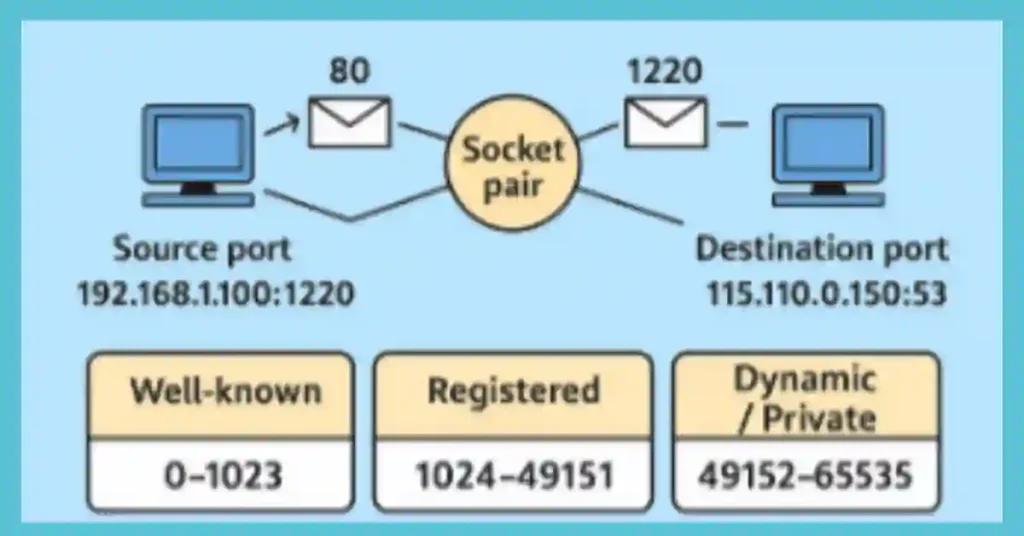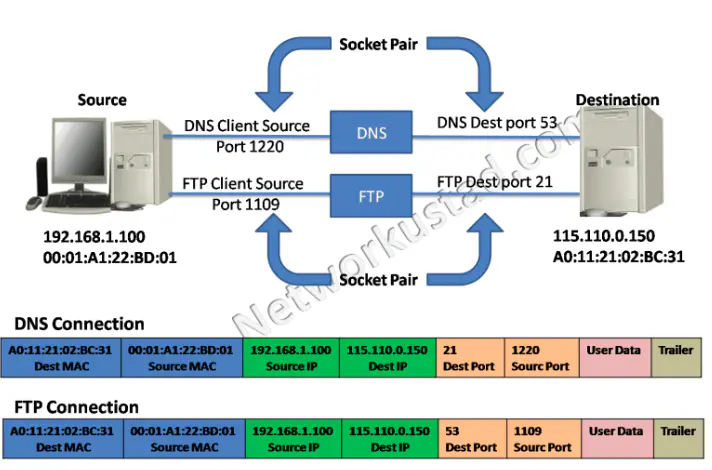Virtual Port Numbers Explained: Your Gateway to Smarter Networking with our Exclusive Guide 2025

The transport layer uses two port numbers: the source port and the destination port. The source port numbers belong to the originating application on the local host, while the destination port numbers belong to the destination application on the remote host, crucial for 2025 IoT scalability
Port numbers resolve the protocol to which incoming traffic should be directed. It allows a single host with a single IP address to run different network services simultaneously. Each port number identifies a separate service, and each host can have 65535 ports per IP address. A client on 192.168.1.100 might use source port 5000 for HTTP to 115.110.0.150:80, while another session uses 5001, enabling multiple browser tabs. The types of ports are:-
Source Port
The originating device dynamically generates source port numbers (e.g., 5000-6000) to identify conversations, enabling multiple simultaneous HTTP requests to a web server, tracked for efficiency in 2025
Destination Port
The host includes the destination port in the segment to specify the requested service, e.g., port 53 for DNS, port 80 for HTTP, or port 443 for HTTPS, streamlining service access in 2025.
A server can offer multiple services simultaneously, such as DNS services on port 53, FTP service on port 21, and web services on port 80. The figure below illustrates the services of more than one service simultaneously.

Port Security
Secure well-known ports (e.g., 80, 443) with firewalls using iptables -A INPUT -p tcp --dport 80 -j ACCEPT, preventing unauthorized access in 2025 networks as of July 2025.
Troubleshooting Ports
Use netstat -an to check active ports and telnet 115.110.0.150 21 to test connectivity, resolving port conflicts.
Port Allocation Details
Dynamic ports are assigned by the OS (e.g., Windows uses 49152-65535 by default), reusable after session closure, optimizing resource use in 2025 high-traffic networks.
Socket Pairs
Source and destination ports are placed within the segment, and then the segments are encapsulated within an IP packet. The IP packet contains the source and destination IP addresses. The combination of the source IP address and source port number, or the destination IP address and destination port number, is known as a socket. We can recognize the server and service requested by the user using a socket.
A user socket might look like this: 192.168.1.100:1220, while the port number is 1220. The socket on an FTP server might be 115.110.0.150:21. Both source and destination sockets combine to form a socket pair: for example, 192.168.1.100:1220 and 115.110.0.150:53 are a socket pair. The Figure above illustrates the connection and socket of DNS and FTP ports.
Sockets enable multiple client processes by combining IP addresses and ports (e.g., 192.168.1.100:1220), with the source port serving as a return address for replies
Configure a socket pair (e.g., 192.168.1.100:1220 to 115.110.0.150:21) using netstat -an | find “21” to verify FTP connections, optimizing network tracking in July 2025.
Port Numbers Groups
The Internet Assigned Numbers Authority (IANA) assigns ports from 0 to 65535, divided into three types. Well-known ports (0-1023) are reserved for services like email clients, web browsers, and remote access, programmable for server apps.
Port Range
| Port Range | Type | Examples | Usage |
|---|---|---|---|
| 0-1023 | Well-known | 80 (HTTP), 53 (DNS) | Server services |
| 1024-49151 | Registered | 3306 (MySQL) | User-installed apps |
| 49152-65535 | Dynamic/Private | 5000-6000 (ephemeral) | Client session tracking |
Well-known Port Numbers
Well-known ports start at 0 and range to 1023. These ports are reserved for service and application. Applications such as email clients, web browsers, and remote access clients use these ports. We can program well-known ports for server applications, and also a client application to request a connection to that specific port and its associated service.
Registered Port Number
The range of registered ports is from 1024 to 49151. The Internet Assigned Numbers Authority (IANA) assigned registered ports upon requesting that the person use them with particular processes or applications. These processes are generally individual applications a user has selected to install and use rather than common applications that would receive a well-known port number.
Dynamic or Private Port Numbers
The range of dynamic or private ports is from 49152 to 65535. The dynamic or private ports are also known as ephemeral ports. The ephemeral ports are generally assigned dynamically to the client’s operating system when a connection to a service is initiated.
We can use dynamic ports to identify the client’s application during communication. Some client operating systems also use a registered port as an alternative to a dynamic port for assigning source ports.
Socket Tracking Mechanisms
The transport layer uses a socket table to map port pairs to applications, updated with netstat -an, ensuring accurate data routing in 2025.
FAQs
-
Port numbers are virtual points where network connections start and end, enabling data exchange between devices. They range from 0 to 65535, categorized into well-known, registered, and dynamic ports, as shown in the diagram.
Email Protocols – SMTP, POP and IMAP » Networkustad
August 8, 2019 @ 10:45 am
[…] a client sends an email message, the client SMTP process connects with a server SMTP process on port 25. When the client and server set up a connection, then the client tries to send the email message […]
November 14, 2022 @ 1:45 pm
When a client sends an email, the client’s SMTP process establishes a connection with the server’s SMTP process on port 25. The client tries to send the email message after the server and client establish a connection.